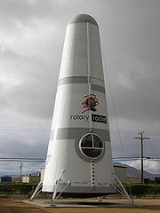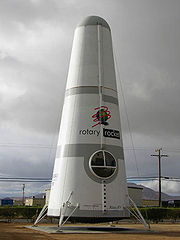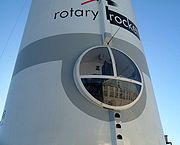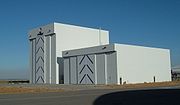
Rotary Rocket
Encyclopedia

Single-stage-to-orbit
A single-stage-to-orbit vehicle reaches orbit from the surface of a body without jettisoning hardware, expending only propellants and fluids. The term usually, but not exclusively, refers to reusable vehicles....
(SSTO) manned spacecraft
Spacecraft
A spacecraft or spaceship is a craft or machine designed for spaceflight. Spacecraft are used for a variety of purposes, including communications, earth observation, meteorology, navigation, planetary exploration and transportation of humans and cargo....
. Roton was intended to reduce costs of launching payloads into low earth orbit by a factor of ten. Gary Hudson
Gary Hudson
Gary Hudson has been involved in private spaceflight development for over 25 years.Hudson is best known as the founder of Rotary Rocket Company, which in spending ~$30 Million attempted to build a unique single stage to orbit launch vehicle known as the Roton...
championed the design and formed the company. A full-scale test vehicle made three hover flights in 1999, but the company ran out of funds and closed its doors in early 2001.
Helicopter to orbit
Gary Hudson's and Bevin McKinney's initial concept was to merge a rocket with a helicopter: spinning blades, powered by tip jets, would lift the vehicle in the earliest stage of launch. Once the air thinned to the point that helicopter flight was impractical, the vehicle would continue on pure rocket power, with the rotor acting as a giant turbopumpTurbopump
A turbopump is a gas turbine that comprises basically two main components: a rotodynamic pump and a driving turbine, usually both mounted on the same shaft, or sometimes geared together...
.
Calculations showed that the helicopter blades modestly increased the effective specific impulse
Specific impulse
Specific impulse is a way to describe the efficiency of rocket and jet engines. It represents the derivative of the impulse with respect to amount of propellant used, i.e., the thrust divided by the amount of propellant used per unit time. If the "amount" of propellant is given in terms of mass ,...
(Isp) by about 20–30 seconds, essentially only carrying the blades into orbit "for free". Thus, there was no overall gain from this method during ascent. However, the blades could be used to soft land the vehicle, so the landing system cost nothing.
One problem found during research at Rotary was that once the vehicle left the atmosphere additional thrust would be necessary. Thus multiple engines would be needed at the tips as well as the base. Another issue would be noise that the rocket tipped rotor is likely to be extraordinarily noisy, as was the Fairey Rotodyne.
This version of the Roton had been designed with the small communications satellite market in mind. However, this market crashed, signaled by the failure of Iridium Communications Inc.. Consequently, Roton had to be redesigned for heavier payloads.
Helicopter from orbit
The Roton was a cone-shaped launch vehicle, with a helicopter rotor on top for use only during landing. An internal cargo bay could be used both for carrying payloads to orbit and bringing others back to Earth. The projected price to orbit of this design was given as $1000 per kg of payload, less than 1/10 of the then-current launch price. Payload capacity was limited to a relatively modest 3 tons.The company intended to use a unique rotating annular aerospike engine
Aerospike engine
The aerospike engine is a type of rocket engine that maintains its aerodynamic efficiency across a wide range of altitudes through the use of an aerospike nozzle. It is a member of the class of altitude compensating nozzle engines. A vehicle with an aerospike engine uses 25–30% less fuel at low...
: the engine and base of the launch vehicle would spin at high speed (720 rpm
Revolutions per minute
Revolutions per minute is a measure of the frequency of a rotation. It annotates the number of full rotations completed in one minute around a fixed axis...
) to pump fuel and oxidizer to the rim by the rotation. Unlike the landing rotor, due to the shallow angle of the nozzles in the base rotor, the rotation speed self limited and required no control system. Since the density of the LOX (liquid oxygen
Liquid oxygen
Liquid oxygen — abbreviated LOx, LOX or Lox in the aerospace, submarine and gas industries — is one of the physical forms of elemental oxygen.-Physical properties:...
) was higher than that of the Kerosene, extra pressure was available with the LOX, and it was to be used to cool the engines (throat etc.). However, at the high G levels at the outer edge of the rotating engine block, clarity on how LOX would work as a coolant was both unknown and difficult to validate. That added one layer of risk. In addition, the rotating exhaust acted as an effective wall at the outer edge of the engine base, and the entire base area effectively is pumped down below ambient due to ejector pump effect, creating an effective suction cup at the bottom in atmosphere. This could be alleviated using makeup gas to develop base pressure, requiring effectively an additional rocket engine to fill up the base of the main rocket engine. At the rim, 96 miniature jets would shoot the burning propellants (LOX and kerosene
Kerosene
Kerosene, sometimes spelled kerosine in scientific and industrial usage, also known as paraffin or paraffin oil in the United Kingdom, Hong Kong, Ireland and South Africa, is a combustible hydrocarbon liquid. The name is derived from Greek keros...
) around the rim of the base of the vehicle, which gained the vehicle extra thrust at high altitude- effectively acting as a zero-length truncated aerospike nozzle. A similar system with non-rotating engines was studied for the N1 rocket
N1 rocket
N-1 was a heavy lift rocket intended to deliver payloads beyond low Earth orbit, acting as the Soviet counterpart to the NASA Saturn V rocket. This heavy lift booster had the capability of lifting very heavy loads into orbit, designed with manned extra-orbital travel in mind...
. That application had a much smaller base area, and did not create the suction effect a larger peripheral engine induces. The Roton engine had a projected vacuum ISP (specific impulse)
Specific impulse
Specific impulse is a way to describe the efficiency of rocket and jet engines. It represents the derivative of the impulse with respect to amount of propellant used, i.e., the thrust divided by the amount of propellant used per unit time. If the "amount" of propellant is given in terms of mass ,...
of ~355 seconds (3.5 kN·s/kg), which is very high for a LOX/Kerosene engine — and a thrust to weight ratio of 150, which is extremely light.
During reentry, the base also served as a water-cooled heatshield. This was theoretically a good way to survive reentry, particularly for a lightweight reusable vehicle. However, using water as a coolant would require converting it into superheated steam, at high temperatures and pressures, and there were concerns about micrometeorite damage on orbit puncturing the pressure vessel, causing the reentry shield to fail. These concerns were resolved using a failure resistant massively redundant flow system, created using thin metal sheets etched via chem etch with a pattern of micropores, with a channel system such that it was robust against failure and damage. In addition, cooling was achieved two different ways; one way was the vaporization of the water, but the second was even more significant, and was due to the creation of a layer of "cool" steam surrounding the base surface, reducing the ability to heat. Further, the water metering system would have to be extremely reliable, giving one drop per second per square inch, and was achieved via a trial/error design approach on real hardware. By the end of the ROTON program, some hardware had been built and tested. The reentry trajectory was to be trimmed, similar to the Soyuz, to minimize the G loads on the passengers. And the ballistic coefficient was better for the Roton and could be better tailored. When the Soyuz trim system failed and it went full ballistic, the G levels did rise significantly but without incident to the passengers.
The vehicle was also unique in planning to use its helicopter
Helicopter
A helicopter is a type of rotorcraft in which lift and thrust are supplied by one or more engine-driven rotors. This allows the helicopter to take off and land vertically, to hover, and to fly forwards, backwards, and laterally...
-style rotor
Helicopter rotor
A helicopter main rotor or rotor system is a type of fan that is used to generate both the aerodynamic lift force that supports the weight of the helicopter, and thrust which counteracts aerodynamic drag in forward flight...
s for landing, rather than wings or parachutes. This concept allowed controlled landings (unlike parachutes), and it was 1/5 the weight of fixed wings. Another advantage was that a helicopter could land almost anywhere, whereas winged spaceplane
Spaceplane
A spaceplane is a vehicle that operates as an aircraft in Earth's atmosphere, as well as a spacecraft when it is in space. It combines features of an aircraft and a spacecraft, which can be thought of as an aircraft that can endure and maneuver in the vacuum of space or likewise a spacecraft that...
s such as the Shuttle had to make it back to the runway.
The rotor blades were to be powered by peroxide tip rockets. The rotor blades were to be deployed before reentry; some questions were raised about whether the blades would survive until landing. The initial plan was to have them almost vertical, but that was found to be unstable as they needed to drop lower and lower and spin faster and faster for stability, the heating rates went up dramatically and the air flow became more head on. The implication of that was that the blades went from a lightly heated piece of hardware to one that either had to be actively cooled or made of SiC or other refractory material. The idea of popping out the blades became much more attractive at this point, and initial studies were made for that option. This rotor design concept was not without precedent. In 1955, one of five Soviet designs for planned suborbital piloted missions was to include rocket-tipped rotors as its landing system. On May 1, 1958 these plans were dropped as a decision was made to proceed directly to orbital flights.
Rotary Rocket designed and pressure-tested an exceptionally lightweight but strong composite
Composite material
Composite materials, often shortened to composites or called composition materials, are engineered or naturally occurring materials made from two or more constituent materials with significantly different physical or chemical properties which remain separate and distinct at the macroscopic or...
LOX tank. It survived a test program which involved it being pressure cycled and ultimately deliberately shot to test its ignition sensitivity. This composite construction was a world first.
Roton C-9 specifications
- Overall dimensions:
- Height: 63 ft (19.2 m)
- Maximum diameter: 22 ft (6.7 m)
- Cargo bay dimensions:
- Length: 16.7 ft (5.1 m)
- Diameter: 12 ft (3.7 m)
- Total mass (estimated): 400,000 lb (180,000 kg)
- Low Earth Orbit payload (projected): 7,000 lb (3,180 kg)
- Orbit apogee (projected): 160 mi (260 km)
- Engine thrust: 6,950 lb (30,860 N)
- Engine specific impulse (vac): 340 sec
- Number of engines: 72
(Projections are based on estimates reported in Aviation Week & Space Technology
Aviation Week & Space Technology
Aviation Week & Space Technology, often abbreviated Aviation Week or AW&ST, is a weekly magazine owned and published by McGraw-Hill...
on October 5, 1998.) Also see:
A new engine
In June 1999, Rotary Rocket announced that it would use a derivative of the FastracFastrac (engine)
Fastrac or alternatively MC-1 engine was a pump-fed liquid rocket engine developed by NASA for use on small inexpensive, expendable rockets...
engine under development at NASA
NASA
The National Aeronautics and Space Administration is the agency of the United States government that is responsible for the nation's civilian space program and for aeronautics and aerospace research...
's Marshall Space Flight Center
Marshall Space Flight Center
The George C. Marshall Space Flight Center is the U.S. government's civilian rocketry and spacecraft propulsion research center. The largest center of NASA, MSFC's first mission was developing the Saturn launch vehicles for the Apollo moon program...
, instead of the company's own unconventional spinning engine design. Reportedly, the company had been unable to convince investors that its engine design was viable; the composite structure and gyrocopter reentry was an easier sell.
At the same time as this change, the company laid off about a third of its employees, lowering approximate headcount from 60 to 40. At this point, the company planned to begin its commercial launch service sometime in 2001. Although the company had raised $30 million, it still needed to raise an additional $120 million before entering service.
The Atmospheric Test Vehicle (ATV)

Scaled Composites
Scaled Composites is an aerospace company founded by Burt Rutan and currently owned by Northrop Grumman that is located at the Mojave Spaceport, Mojave, California, United States...
for use in hover test flights. The $2.8 million ATV was not intended as an all-up test article, since it had no rocket engine and no heat shielding. The ATV was rolled out of its Mojave hangar on March 1, 1999, bearing an FAA registry of N990RR.
The rotor head was salvaged from a crashed Sikorsky S-58, at a price of $50,000 — as opposed to as much as $1 million for a new head. Each rotor was powered by a 350-lbf (1,560 N) hydrogen peroxide
Hydrogen peroxide
Hydrogen peroxide is the simplest peroxide and an oxidizer. Hydrogen peroxide is a clear liquid, slightly more viscous than water. In dilute solution, it appears colorless. With its oxidizing properties, hydrogen peroxide is often used as a bleach or cleaning agent...
jet, as intended for the orbital vehicle. The rotor assemblage was tested in a rock quarry before installation on the ATV.
The ATV flew three successful test flights in 1999. The pilot for these three flights was Marti Sarigul-Klijn
Marti Sarigul-Klijn
A U.S. Naval test pilot, Dr. Marti Sarigul-Klijn holds a Ph.D. in Aeronautical Engineering from the U.S. Naval Postgraduate School. He is noted for having developed and flown the Rotary Rocket Atmospheric Test Vehicle. He retired the Navy at the rank of Commander, after having served for twenty...
and the copilot was Brian Binnie
Brian Binnie
William Brian Binnie is a former United States Navy officer and is one of the test pilots for SpaceShipOne, the experimental spaceplane developed by Scaled Composites.-History:...
(who later gained fame as pilot of Scaled Composites' SpaceShipOne on its second X-Prize
Ansari X Prize
The Ansari X Prize was a space competition in which the X Prize Foundation offered a US$10,000,000 prize for the first non-government organization to launch a reusable manned spacecraft into space twice within two weeks...
flight).
The ATV made its first flight on July 28. This flight consisted of three vertical hops totaling 4 min 40 sec in duration and reaching a maximum altitude of 8 ft (2.4 m). The pilots found the flying extremely challenging for a number of reasons. Visibility in the cockpit was so restricted that the pilots nicknamed it the "bat cave". The view of the ground was entirely obstructed, so the pilots had to rely on a sonar altimeter to judge ground proximity. The entire craft had a low rotational inertia, and torque from the spinning rotor blades made the body spin, unless counteracted by yaw thrust in the opposite direction.
The second flight, on September 16, was a continuous hover flight lasting 2 min 30 sec, reaching a maximum altitude of 20 ft (6.1 m). The sustained flight was made possible by the installation of more powerful rotor tip thrusters and an autothrottle
Autothrottle
An autothrottle allows a pilot to control the power setting of an aircraft's engines by specifying a desired flight characteristic, rather than manually controlling fuel flow...
.
The third and last flight was made on October 12. The ATV flew down the flightline at Mojave Airport, covering 4,300 ft (1,310 m) in its flight and rising to a maximum altitude of 75 ft (23 m). The speed was as high as 53 mph (85 km/h). This test revealed some instability in translational flight.
A fourth test was planned to simulate a full autorotative descent. The ATV would climb to an altitude 10,000 ft (3,050 m) under its own power, before throttling back and returning for a soft landing. At this point, given that further funding was then unlikely, safety considerations prevented the test being attempted.
Criticism of the design
Rotary Rocket failed due to lack of funding, but some have suggested that the design itself was inherently flawed.On the one hand, Rotary Rocket demonstrated technical ability in the testing of actual hardware. The ATV flew three test flights and a composite propellant tank survived a full test program. As Jim Ransom, Rotary Rocket consultant, pointed out at the demise of the company, this was more than could be said for Lockheed Martin
Lockheed Martin
Lockheed Martin is an American global aerospace, defense, security, and advanced technology company with worldwide interests. It was formed by the merger of Lockheed Corporation with Martin Marietta in March 1995. It is headquartered in Bethesda, Maryland, in the Washington Metropolitan Area....
's X-33
Lockheed Martin X-33
The Lockheed Martin X-33 was an unmanned, sub-scale technology demonstrator suborbital spaceplane developed in the 1990s under the U.S. government-funded Space Launch Initiative program. The X-33 was a technology demonstrator for the VentureStar orbital spaceplane, which was planned to be a...
, which had a budget 30 times larger.
On the other hand, these tests revealed problems. For instance, the ATV demonstrated that a landing of the Rotary Rocket would be tricky, even dangerous. Test pilots have a rating system, the Cooper-Harper rating scale
Cooper-Harper rating scale
The Cooper-Harper rating scale is a set of criteria used by test pilots and flight test engineers to evaluate the handling qualities of aircraft during flight test. The scale ranges from 1 to 10, with 1 indicating the best handling characteristics and 10 the worst. The criteria are evaluative and...
, for vehicles between 1 and 10 that relates to difficulty to pilot. The Roton ATV scored a 10 — the vehicle simulator was found to be practically unflyable by anyone except the Rotary test pilots, and even then there were expected to be short periods where the vehicle was out of control.
Other aspects of the flight plan remained unproven. It is not known whether Roton could in practice have developed enough overall performance to reach orbit with a single stage, and return — although on paper this might have been possible. These doubts led some of the aerospace community to dismiss the Rotary Rocket concept as an impossible pipe dream.
Whether the full-up vehicle would have worked remains open to speculation.
The Last Days of Rotary Rocket

The timing of the venture was unfortunate: the Iridium fiasco was coming to a head, and the whole space industry was feeling the pinch. Ultimately, the company did not attract sufficient funding (even though numerous individuals provided a total of $33 million of support, including writer Tom Clancy
Tom Clancy
Thomas Leo "Tom" Clancy, Jr. is an American author, best known for his technically detailed espionage, military science, and techno thriller storylines set during and in the aftermath of the Cold War, along with video games on which he did not work, but which bear his name for licensing and...
).
Some of the engineers that worked there have since set up other rocketry ventures, notably XCOR Aerospace
XCOR Aerospace
XCOR Aerospace is an American private rocket engine and spaceflight development company based at the Mojave Spaceport in Mojave, California. XCOR was formed by former members of the Rotary Rocket rocket engine development team in September, 1999...
, t/Space
T/Space
t/Space is an American aerospace company which was participating in NASA's Commercial Orbital Transportation Services program for delivering cargo and crew to the International Space Station. The company's CEO is Charles Duelfer who ran the search for weapons of mass destruction in Iraq and the...
and Space Launch.
The Atmospheric Test Vehicle was to be displayed at Classic Rotors Museum
Classic Rotors Museum
Classic Rotors is a flying aviation museum specializing in helicopters and other rotorcraft, located at the Ramona Airport in Ramona, California, United States....
, a helicopter museum near San Diego, California
San Diego, California
San Diego is the eighth-largest city in the United States and second-largest city in California. The city is located on the coast of the Pacific Ocean in Southern California, immediately adjacent to the Mexican border. The birthplace of California, San Diego is known for its mild year-round...
, but an attempt to move it there on May 9, 2003 via a short-line sling-load under an Army Reserve CH-47 Chinook
CH-47 Chinook
The Boeing CH-47 Chinook is an American twin-engine, tandem rotor heavy-lift helicopter. Its top speed of 170 knots is faster than contemporary utility and attack helicopters of the 1960s...
failed when the Roton began to oscillate at airspeeds above 35 knots (68.6 km/h). Instead, the Mojave Airport administration worked to keep this historic vehicle at Mojave, and on November 10, 2006, the Roton was moved to its permanent display location at the intersection of Airport Blvd and Sabovich Road. To many, the Roton represents the program that launched Mojave into the Space Age, and this theme was echoed during the dedication ceremony that took place during the Veterans' Day celebration on November 11, at which Brian Binnie
Brian Binnie
William Brian Binnie is a former United States Navy officer and is one of the test pilots for SpaceShipOne, the experimental spaceplane developed by Scaled Composites.-History:...
was the keynote speaker.
The Rotary Rocket hangars are now occupied by the National Test Pilot School
National Test Pilot School
The National Test Pilot School is a civilian test pilot school located at the Mojave Air & Space Port in Mojave, California. The school attracts students primarily from commercial aircraft manufacturers and military air forces...
.
External links
- Roton article at Encyclopedia AstronauticaEncyclopedia AstronauticaThe Encyclopedia Astronautica is a reference web site on space travel. A comprehensive catalog of vehicles, technology, astronauts, and flights, it includes information from most countries that have had an active rocket research program, from Robert Goddard to the NASA Space shuttle to the Soviet...
- Wired magazine article on Roton
- Space.com on test flights
- Space.com on helicopter museum trip
- Quicktime footage of final test flight of Roton ATV, from the Air&Space Magazine website
- Archives of original rotaryrocket.com website, from Internet ArchiveInternet ArchiveThe Internet Archive is a non-profit digital library with the stated mission of "universal access to all knowledge". It offers permanent storage and access to collections of digitized materials, including websites, music, moving images, and nearly 3 million public domain books. The Internet Archive...
Wayback Machine - Tom Brosz's personal account of Rotary Rocket and fallout
- Roton C-9 specs
- Photos of the project from the Mojave Virtual Museum
- Photos from the unveiling of the Roton

